Distant Reading: A Case Study of Gender Issues from the Titles of Thai Novels between 1933 - 1954
Main Article Content
Abstract
Exploring a new research methodology known as digital humanities, the article adopts Moretti’s distant reading method to analyze an early Thai novel database (1933 - 1954). The study reveals that there is an outstanding number of novels using a proper name of the female protagonist as their titles. This reflects a significant change of the status of Thai women. Entitling the novel with the female protagonist’s proper name implies the recognition of a woman as an individual with a free will and self-determination. Such open and unlimited possibilities of the women’s fate also piques the readers’ curiosity as much as their concern.
Downloads
Article Details

This work is licensed under a Creative Commons Attribution-NonCommercial-NoDerivatives 4.0 International License.
References
จิตตมาศ จิระสถิตย์พร. (2560). พัฒนาการทางการศึกษาของผู้หญิงไทย พ.ศ. 2500 - 2540 : หลักสูตรการศึกษากับการพัฒนาผู้หญิงสู่ความทันสมัย [วิทยานิพนธ์ปริญญามหาบัณฑิต]. มหาวิทยาลัยธรรมศาสตร์.
ชูศักดิ์ ภัทรกุลวณิชย์. (2551). สงครามชิงทำเนียบ. อ่าน, 1(3), 17-37.
วิภา กงกะนันทน์. (2540). กำเนิดนวนิยายในประเทศไทย. ดอกหญ้า.
สมิทธ์ ถนอมศาสนะ. (2558). การเปลี่ยนแปลงทางความคิดของชนชั้นกลางไทยกับ “เรื่องอ่านเล่น” ไทยสมัยใหม่ ทศวรรษ 2460 - ทศวรรษ 2480 [วิทยานิพนธ์ปริญญาดุษฎีบัณฑิต]. จุฬาลงกรณ์มหาวิทยาลัย.
สันติ ทองประเสริฐ. (2519). วิวัฒนาการเนื้อหาของนวนิยายไทย ตั้งแต่ พ.ศ. 2476 - 2517 [วิทยานิพนธ์ปริญญามหาบัณฑิต]. มหาวิทยาลัยศรีนครินทรวิโรฒ.
สุนันทา นิตยจินต์. (2530). การศึกษาของสตรีระหว่างพุทธศักราช 2411 ถึง 2475 [วิทยานิพนธ์ปริญญามหาบัณฑิต]. จุฬาลงกรณ์มหาวิทยาลัย.
เสนาะ เจริญพร. (2563). ความรักกับความสัมพันธ์ในสื่อสิ่งพิมพ์ของผู้หญิงช่วงทศวรรษ 2490 [วิทยานิพนธ์ปริญญาดุษฎีบัณฑิต]. มหาวิทยาลัยธรรมศาสตร์.
ศราวุฒิ วิสาพรม. (2559). ราษฎรสามัญ หลังวันปฏิวัติ 2475. มติชน.
อภิชาต สถิตนิรามัย. (2556). รัฐไทยกับการปฏิรูปเศรษฐกิจ : จากกำเนิดทุนนิยมนายธนาคารถึงวิกฤตเศรษฐกิจ 2540. ฟ้าเดียวกัน.
อรชุมา เก่งชน. (2545). การเคลื่อนไหวของกระแสสตรีนิยมยุคบุกเบิกที่ปรากฏในนิตยสาร [วิทยานิพนธ์ปริญญามหาบัณฑิต]. จุฬาลงกรณ์มหาวิทยาลัย.
อิสระ ชูศรี. (2562). อ่านใกล้/อ่านไกล ชูศักดิ์กับภูเขาน้ำแข็งของเฮมิงเวย์. ใน สุธิดา วิมุตติโกศล (บรรณาธิการ), อ่านคนละเรื่อง (น. 31-46). สาขาวิชาภาษาและวรรณคดีอังกฤษ, คณะศิลปศาสตร์, มหาวิทยาลัยธรรมศาสตร์.
อุบลวรรณ ปิติพัฒนะโฆษิต, และ อวยพร พานิช. (2532). 100 ปี ของนิตยสารสตรีไทย (พ.ศ. 2431-2531). คณะนิเทศศาสตร์ จุฬาลงกรณ์มหาวิทยาลัย.
Algee-Hewitt, M., & McGurl, M. (2015). Between Canon and Corpus : Six Perspectives on 20th-Century Novels. Stanford Literary Lab : Pamphlets 8. http://litlab.stanford.edu/LiteraryLabPamphlet8.pdf
Ascari, M. (2014). The Dangers of Distant Reading : Reassessing Moretti's Approach to Literary Genres. Genre, 47(1), 1-19.
Barthes, R. (1988). Textual Analysis of a Tale by Edgar Allan Poe. In The Semiotic Challenge (1st ed., pp. 261-293). Hill and Wang.
Berry, D. M. (2012). Understanding Digital Humanities. Palgrave Macmillan.
Bode, K. (2018). Abstraction, Singularity, Textuality : The Equivalence of “Close” and “Distant” Reading. In A World of Fiction: Digital Collections and the Future of Literary History (pp. 17-36). University of Michigan Press. http://www.jstor.org/stable/j.ctvdtpj1d.5
Burdick, A., Drucker, J., Lunenfeld, P., Presner, T., & Schnapp, J. T. (2012). Digital_ Humanities. MIT Press.
Drouin, J. (2014). Close- and Distant-Reading Modernism : Network Analysis, Text Mining, and Teaching the Little Review. The Journal of Modern Periodical Studies, 5(1), 110-135.
Erlin, M., & Tatlock, L. (Eds.). (2014). Distant Readings : Topologies of German Culture in the Long Nineteenth Century. Boydell & Brewer.
Hackler, R., & Kirsten, G. (2016). Distant Reading, Computational Criticism, and Social Critique. An Interview with Franco Moretti. Le foucaldien, 2(1). 1-17. https://doi.org/10.16995/lefou.22
Hayles, N. K. (2013). Combining Close and Distant Reading: Jonathan Safran Foer's "Tree of Codes" and the Aesthetic of Bookishness. PMLA, 128(1), 226-231.
Houston, N. M. (2019). Distant Reading and Victorian Women’s Poetry. In L. K. Hughes (Ed.), The Cambridge Companion to Victorian Women's Poetry (pp. 249-265). Cambridge University Press.
Jänicke, S., Franzini, G., Cheema, M. F., & Scheuermann, G. (2015). On Close and Distant Reading in Digital Humanities : A Survey and Future Challenges. EuroVis. http://dx.doi.org/10.2312/eurovisstar.20151113
Jockers, M. L. (2013). Macroanalysis : Digital Methods and Literary History. University of Illinois Press.
Kanatova, M., Milyakina, A., Pilipovec, T., Shelya, A., Sobchuk, O., & Tinits, P. (2017). Broken time, continued evolution : anachronies in contemporary films. Stanford Literary Labv : Pamphlets 14. https://litlab.stanford.edu/LiteraryLabPamphlet14.pdf
Kontje, T. (2014). The Case for Close Reading after the Descriptive Turn. In L. Tatlock & M. Erlin (Eds.), Distant Readings : Topologies of German Culture in the Long Nineteenth Century (pp. 133-152). Boydell & Brewer.
Monzingo, E., & Shanahan, D. (2021). The Expression of Self and Grief in the Nineteenth Century : An Analysis through Distant Readings. Nineteenth-Century Music Review, 18(1), 83-107.
Moretti, F. (2005). Graphs, Maps, Trees : Abstract Models for a Literary History. Verso.
Moretti, F. (2013a). Conjectures on World Literature. In Distant Reading (pp. 43-62). Verso.
Moretti, F. (2013b). The Novel : History and Theory. In Distant Reading (pp. 159-178). Verso.
Moretti, F. (2013c). Style, Ince : Reflections on 7,000 Titles (British Novels, 1740 - 1850). In Distant Reading (pp. 179-210). Verso.
Moretti, F. (2014). “Operationalizing” : or, the Function of Measurement in Modern Literary Theory. The Journal of English Language and Literature, 60, 3-19.
Prasansak, R. (2020). A Distant Reading of Khamphun Bunthawi’s Luk Isan (A Child of the Northeast) as World Literature. Journal of Letters, 49(2), 1-20.
So, R. J., & Roland, E. (2020). Race and Distant Reading. PMLA, 135(1), 59-73. https://doi.org/10.1632/pmla.2020.135.1.59
Trumpener, K. (2009). Critical Response I : Paratext and Genre System : A Response to Franco Moretti. Critical Inquiry, 36(1), 159-171.
Underwood, T. (2017). A Genealogy of Distance Reading. DAQ : Digital Humanities Quarterly, 11(2), 1-12.
William, V. S. (2017). Against Distant Reading : Retrieving Close Reading in the Interregnum. Symploke, 25(1-2), 247-260.


